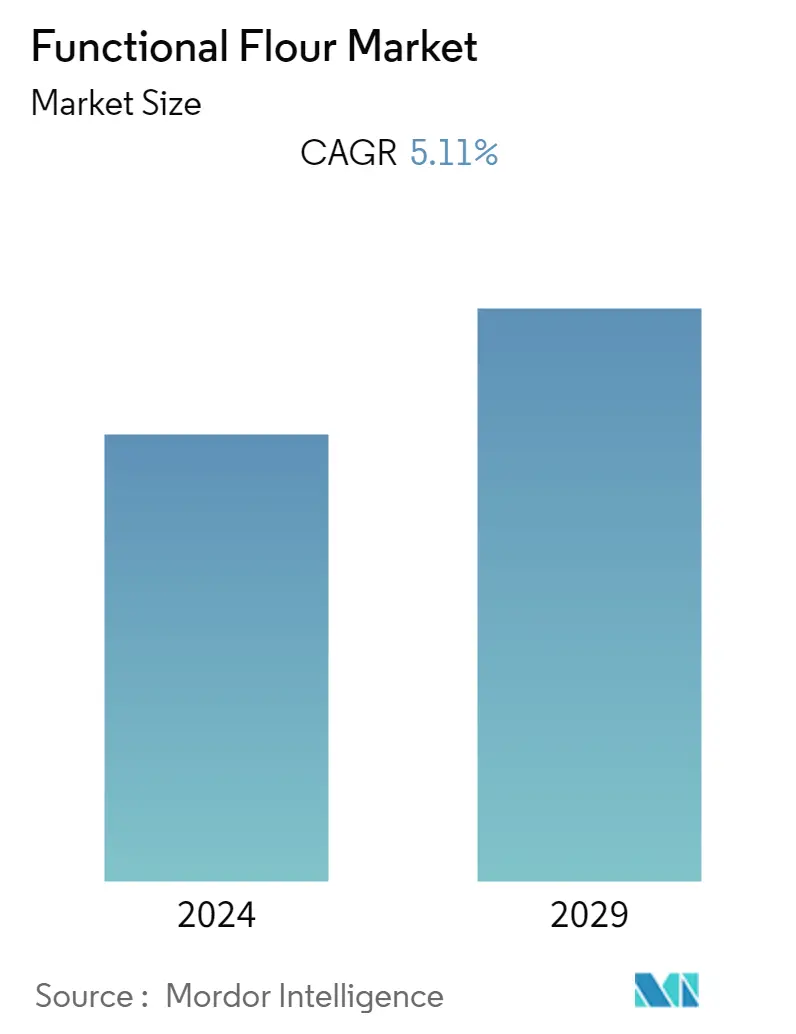Market Size of Functional Flour Industry

| Study Period | 2019 - 2029 |
| Base Year For Estimation | 2023 |
| CAGR | 5.11 % |
| Fastest Growing Market | Asia Pacific |
| Largest Market | North America |
| Market Concentration | Low |
Major Players
*Disclaimer: Major Players sorted in no particular order |
Functional Flour Market Analysis
The Functional Flour Market is projected to register a CAGR of 5.11% during the forecast period.
Functional flour is predicted to become increasingly prevalent as the emphasis on plant-based diets, and more specifically, plant protein, continues to grow as consumer demand increases globally. The categories of flatbreads, biscuits, pastries, cakes, and cookies are a few examples of those with scope for expansion. Since all of these products are cereal-based, there is a chance to develop cereal and pulse-based ingredients to produce mixes that are complementary from the perspective of protein quality, sustainability, and functionality.
Consumers worldwide are striving to adopt a combination of grains, cereals, and lentils in their everyday food for essential nutrients. In addition, increasing gluten allergies are stoking demand for non-wheat-based flour. This is stoking demand for functional flours that are composed of soy flour, rye flour, and oat flour, among others. Moreover, it is common in some nations, particularly those in Africa and Latin America, to combine wheat flour with non-wheat flour made from maize, millet, sweet potatoes, cassava, soybeans, or other ingredients, like yams. The result is referred to as composite flour.
Population growth and lifestyle changes are driving up demand for agricultural and food products. Many food manufacturers are looking for alternative flour to replace wheat flour in new formulations with high nutritive value and bioactive properties. Barley flours enriched in bioactive compounds are appealing ingredients to meet the requirements of the end consumers as they can be easily incorporated into various food matrices.
Functional Flour Industry Segmentation
Functional flours are modified heat or non-traditional flours that claim to improve health benefits beyond that of the nutrition found in flour. Functional flour may also include flours that are fortified with vitamins, herbs, and even nutraceuticals.
The Functional Flour market is segmented by Source (Cereals and Legumes), Type (Specialty Flour and Conventional Flour), Application (Bakery, Savory Snacks, Soups and Sauces, Ready-to-Eat (RTE) Products, and Other Applications); and Geography (North America, Europe, Asia-Pacific, South America, and Middle-East and Africa. The report offers the market size and values in (USD Million) during the forecast years for the above segments.
| Source | |
| Cereals | |
| Legumes |
| Type | |
| Specialty Flour | |
| Conventional Flour |
| Application | |
| Bakery | |
| Savory Snacks | |
| Soups and Sauces | |
| Ready-to-Eat products | |
| Other Applications |
| Geography | |||||||||
| |||||||||
| |||||||||
| |||||||||
| |||||||||
|
Functional Flour Market Size Summary
The functional flour market is experiencing significant growth, driven by the increasing consumer shift towards plant-based diets and the rising demand for gluten-free and nutrient-enriched foods. This trend is fueled by a growing awareness of health benefits and the need for dietary solutions to combat obesity, diabetes, and cardiovascular diseases. Functional flours, which include ingredients like soy, rye, and oat flour, are gaining popularity for their nutritional benefits and versatility in food applications such as flatbreads, biscuits, and energy bars. The market is also seeing a rise in composite flours, particularly in regions like Africa and Latin America, where traditional wheat flour is blended with local ingredients like maize and cassava to enhance nutritional value and functionality.
The market landscape is characterized by a competitive and fragmented environment, with key players such as Cargill Inc., Archer Daniels Midland Company, and Ingredion Inc. actively engaging in product innovation and strategic expansions. These companies are focusing on developing functional flours that offer cost-effective solutions without compromising on taste or texture. The North American region, in particular, is witnessing a surge in demand for premium functional food products, driven by high consumer awareness and the popularity of clean-label offerings. As health consciousness continues to rise, the functional flour market is poised for further expansion, with manufacturers investing in advanced technologies to enhance the protein content and shelf-life of their products.
Functional Flour Market Size - Table of Contents
-
1. MARKET DYNAMICS
-
1.1 Market Drivers
-
1.2 Market Restraints
-
1.3 Industry Attractiveness - Porter's Five Force Analysis
-
1.3.1 Threat of New Entrants
-
1.3.2 Bargaining Power of Buyers/Consumers
-
1.3.3 Bargaining Power of Suppliers
-
1.3.4 Threat of Substitute Products
-
1.3.5 Intensity of Competitive Rivalry
-
-
-
2. MARKET SEGMENTATION
-
2.1 Source
-
2.1.1 Cereals
-
2.1.2 Legumes
-
-
2.2 Type
-
2.2.1 Specialty Flour
-
2.2.2 Conventional Flour
-
-
2.3 Application
-
2.3.1 Bakery
-
2.3.2 Savory Snacks
-
2.3.3 Soups and Sauces
-
2.3.4 Ready-to-Eat products
-
2.3.5 Other Applications
-
-
2.4 Geography
-
2.4.1 North America
-
2.4.1.1 United States
-
2.4.1.2 Canada
-
2.4.1.3 Mexico
-
2.4.1.4 Rest of North America
-
-
2.4.2 Europe
-
2.4.2.1 United Kingdom
-
2.4.2.2 Germany
-
2.4.2.3 France
-
2.4.2.4 Russia
-
2.4.2.5 Italy
-
2.4.2.6 Spain
-
2.4.2.7 Rest of Europe
-
-
2.4.3 Asia-Pacific
-
2.4.3.1 India
-
2.4.3.2 China
-
2.4.3.3 Japan
-
2.4.3.4 Australia
-
2.4.3.5 Rest of Asia-Pacific
-
-
2.4.4 South America
-
2.4.4.1 Brazil
-
2.4.4.2 Argentina
-
2.4.4.3 Rest of South America
-
-
2.4.5 Middle-East and Africa
-
2.4.5.1 South Africa
-
2.4.5.2 Saudi Arabia
-
2.4.5.3 Rest of Middle-East and Africa
-
-
-
Functional Flour Market Size FAQs
What is the current Functional Flour Market size?
The Functional Flour Market is projected to register a CAGR of 5.11% during the forecast period (2024-2029)
Who are the key players in Functional Flour Market?
Cargill, Incorporated, Archer Daniels Midland Company, Associated British Foods plc, Ingredion Incorporated and Bunge Limited are the major companies operating in the Functional Flour Market.

